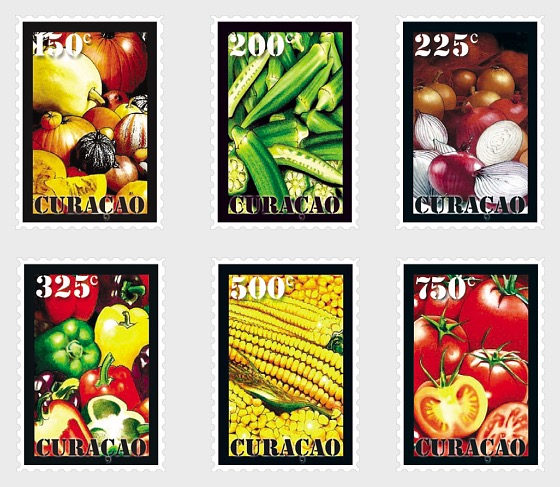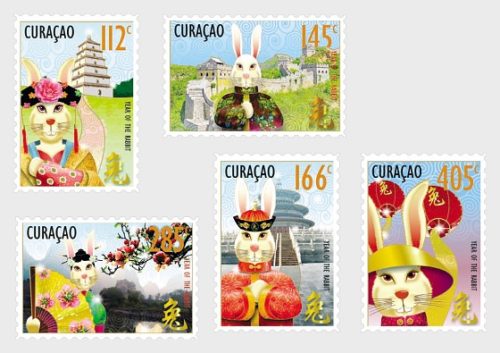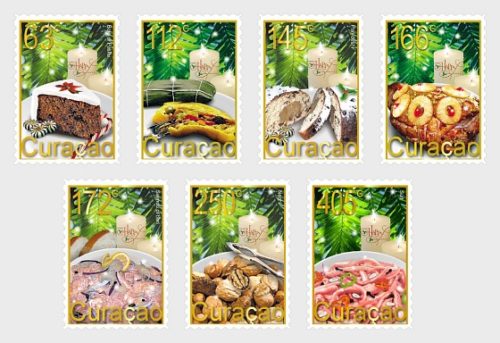Description
The word “vegetable” was first recorded in English in the 15th century, and comes from the Latin word “vegetabilis”.The basic roles of vegetables are to provide a range of vitamins, minerals and antioxidants, that are essential to the wellbeing of the body, and to provide variety and flavor to our food. Nieuwe Post is proud to present this block containing six stamps of the most used vegetables in our country.
150c Stamp PUMPKIN
The origin of pumpkins is not known, although they are thought to have originated in North America. The oldest evidence, pumpkin-related seeds dating between 7000 and 5500 BC, were found in Mexico. Pumpkins are a squash-like fruit that range in size from less than 1 pound to over 1,000 pounds. Pumpkins are monoecious, having both male and female flowers on the same plant. The female flower is distinguished by the small ovary at the base of the petals. These bright and colorful flowers have extremely short life spans and may only open for as short a time as one day. The color of pumpkins is derived from the orange pigments abundant in them. The main nutrients are lutein and both alpha and beta carotene, the latter of which generates vitamin A in the body.
200c Stamp OKRA
Okra, is a hairy, annual plant of the mallow family. It is native to the tropics of the Eastern Hemisphere, for its edible fruit. The leaves are heart-shaped and three- to five-lobed; the flowers are yellow with a crimson centre. The fruit or pod, hairy at the base, is a tapering, 10-angled capsule, contains numerous oval, dark-coloured seeds. Only the tender, unripe fruit is eaten. It is an ingredient in various stews and in the gumbos. The large amount of mucilage (gelatinous substance) it contains, makes it useful as a thickener for broths and soups. In some countries the seeds are used as a substitute for coffee. The leaves and immature fruits have been popular in the East for use in poultices to relieve pain.
225c Stamp ONION
Onion is very popular among the people since ancient times. Both as a spice in making a more delicious cuisine as also for our health. Onion is a plant of the genus Allium and is one of the oldest vegetables and used in many food recipes in many countries. There are many varieties of onions, there is the color purple-colored skin, and there is a pink shade. The most popular onion is the white one, that we use everyday in the kitchen.
325c Stamp PEPPER/PAPRIKA
In many European languages, the name of this spice is somehow derived from the name of pepper. A rather common designation of paprika is sweet pepper. Paprika plants tolerate nearly every climate. The fruits are produced all over the world. A fairly warm climate is, however, necessary for a strong aroma. Garden peppers (pimiento, tabasco, cayenne, chili and paprika) may be grown for food, spices or as ornamentals. The sweet varieties of peppers, are eaten green or ripe and are used for salads, stuffing, soup, stews, relishes and pickling. Peppers contains small amounts of vitamin K and is excellent an source of vitamins A and C.
500c Stamp MAIZE
Maize known in many English-speaking countries as corn, is a grain domesticated by indigenous people in Mesoamerica in prehistoric times. The leafy stalk produces ears which contain seeds called kernels. Though technically a grain, maize kernels are used in cooking as a vegetable or starch. Maize spread to the rest of the world due to its ability to grow in diverse climates. Sugar-rich varieties called sweet corn are usually grown for human consumption, while field corn varieties are used for animal feed and as chemical feedstocks.
750c Stamp TOMATO
The word “Tomato” may refer to the plant or the edible, typically red, fruit which it bears. Originating in South America, the tomato was spread around the world following the Spanish colonization of the Americas, and its many varieties are now widely grown, often in greenhouses in cooler climates. The tomato fruit is consumed in diverse ways, including raw, as an ingredient in many dishes and sauces and in drinks. While it is botanically a fruit, it is considered a vegetable for culinary purposes. The fruit is rich in lycopene, which may have beneficial health effects.
![VEGETABLES_2011[1]](https://www.cpostinternational.com/wp-content/uploads/2018/12/VEGETABLES_20111.jpg)




